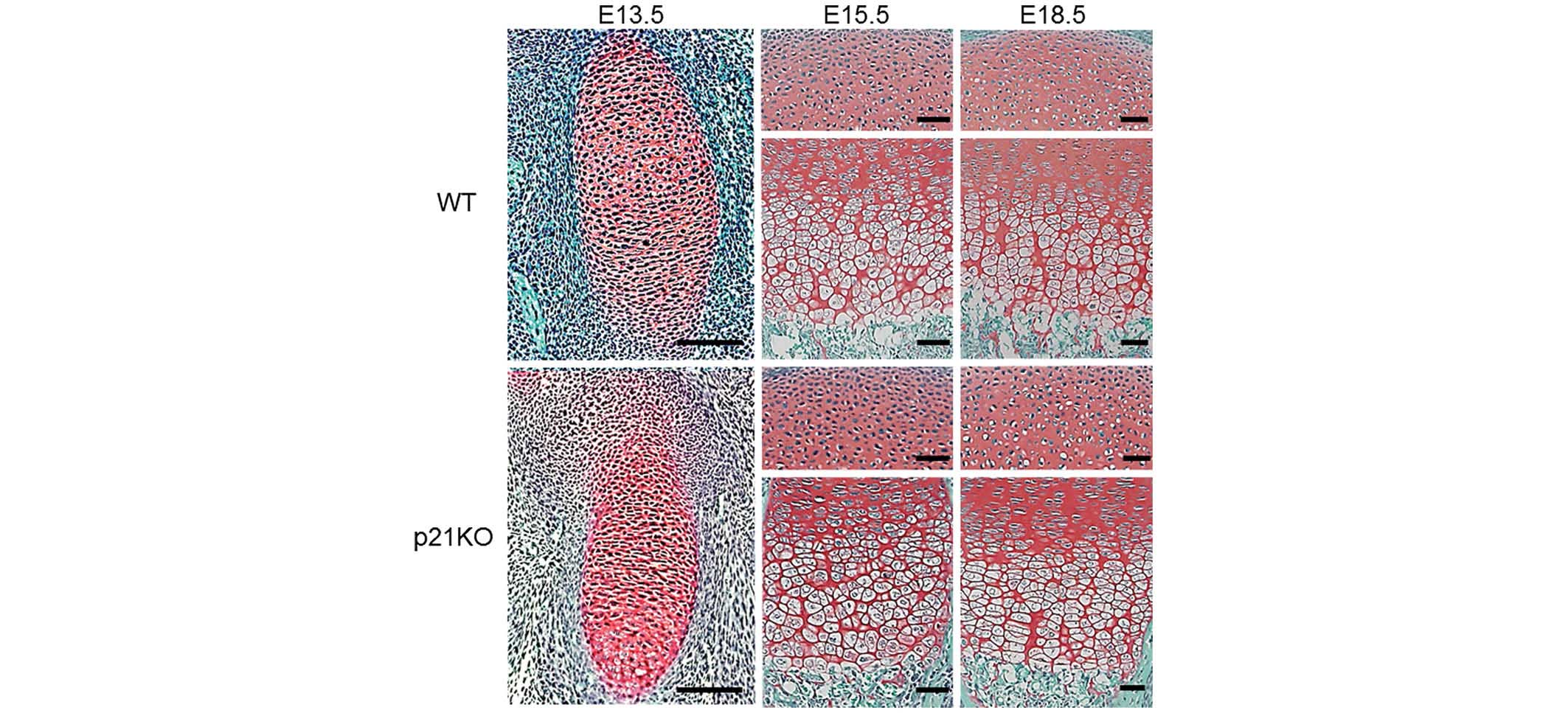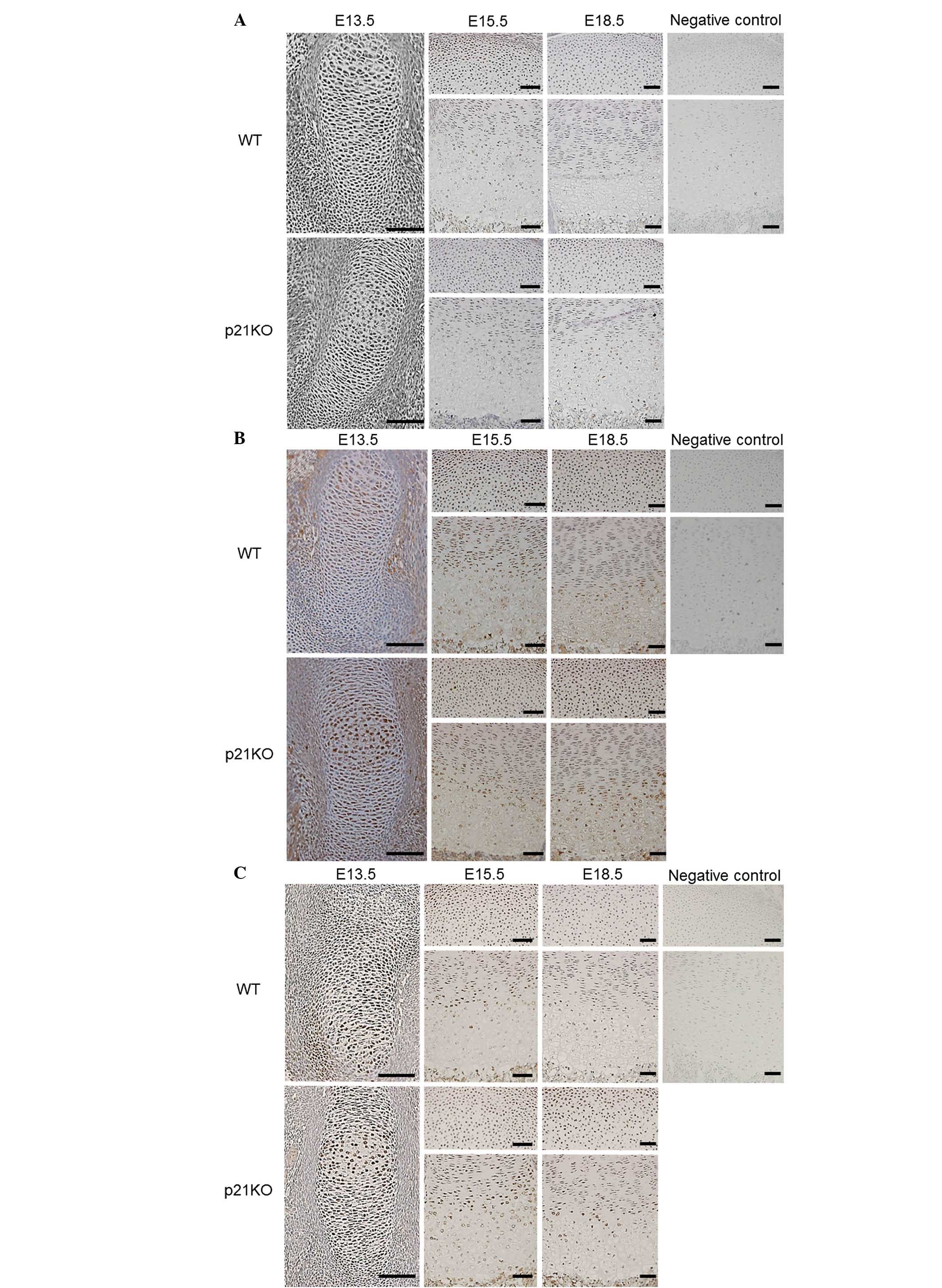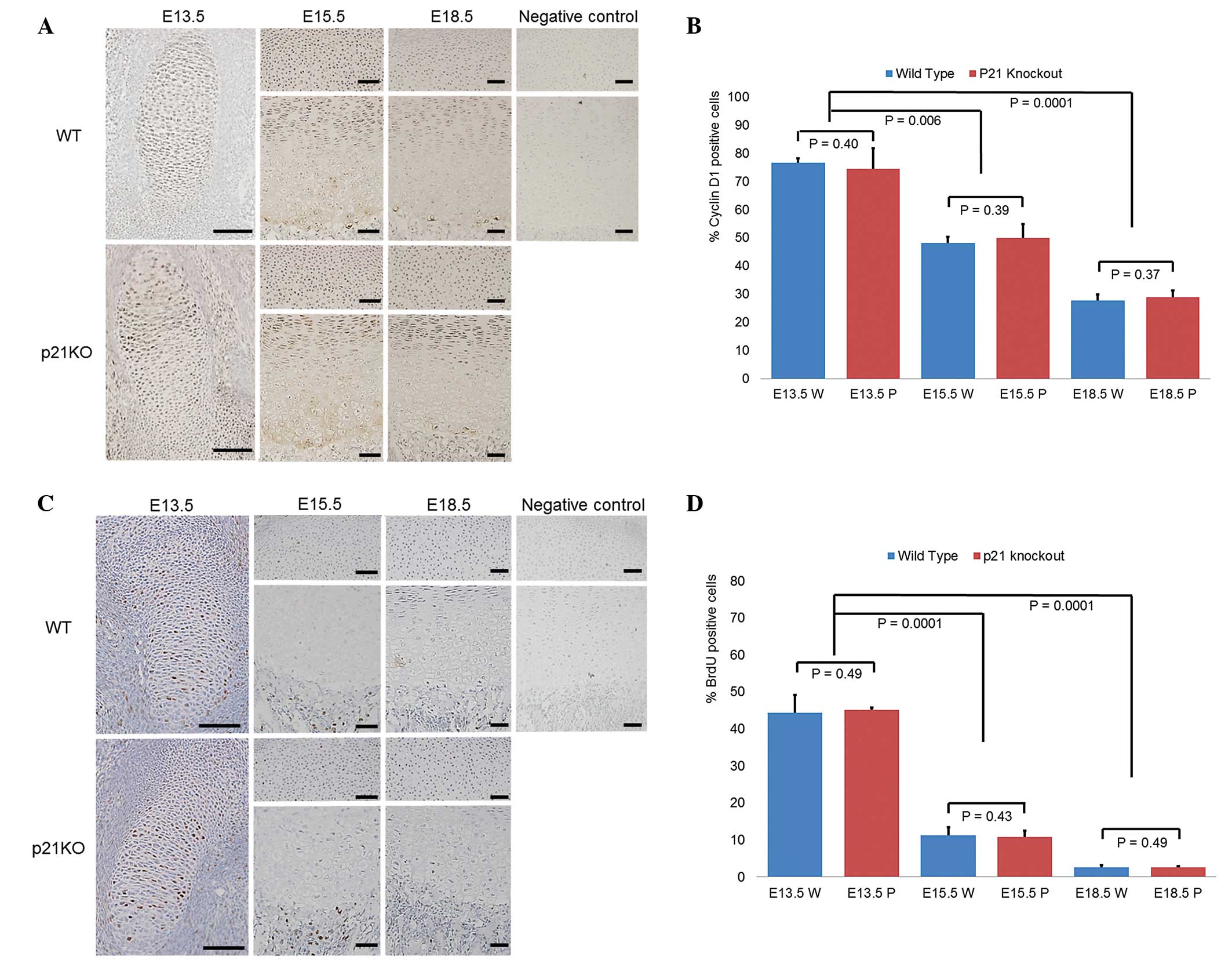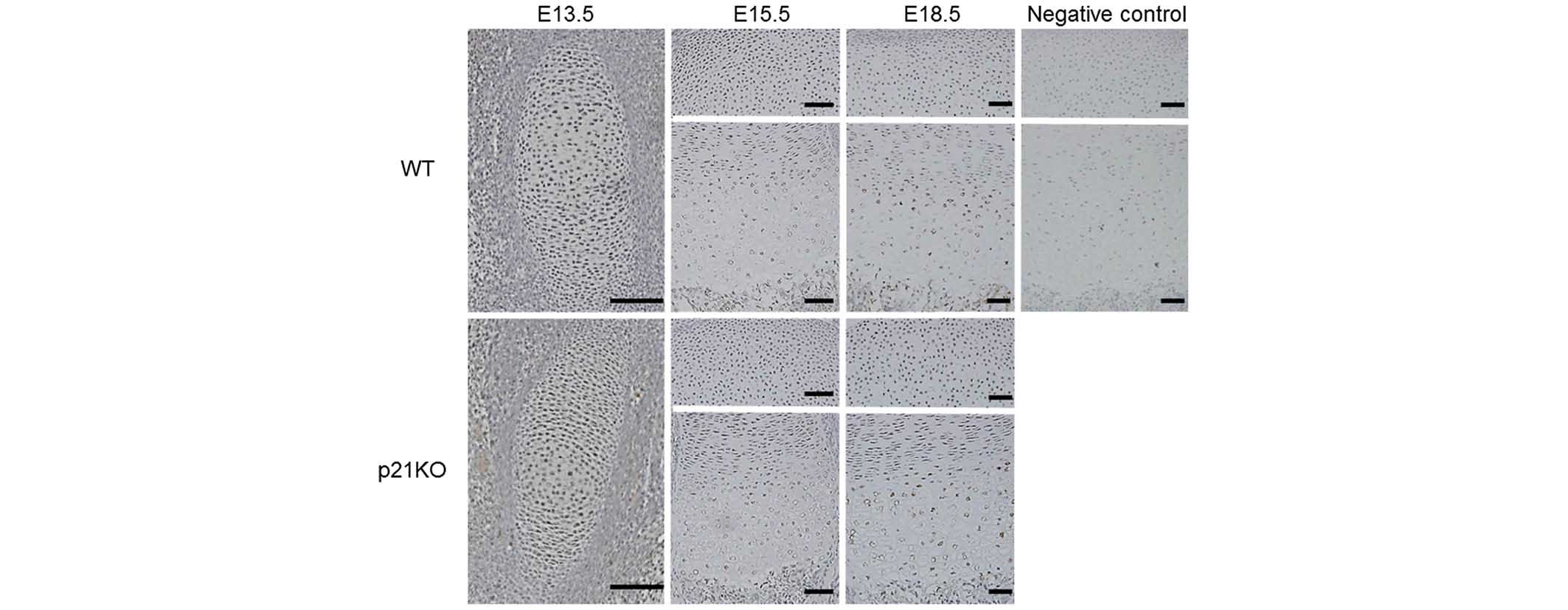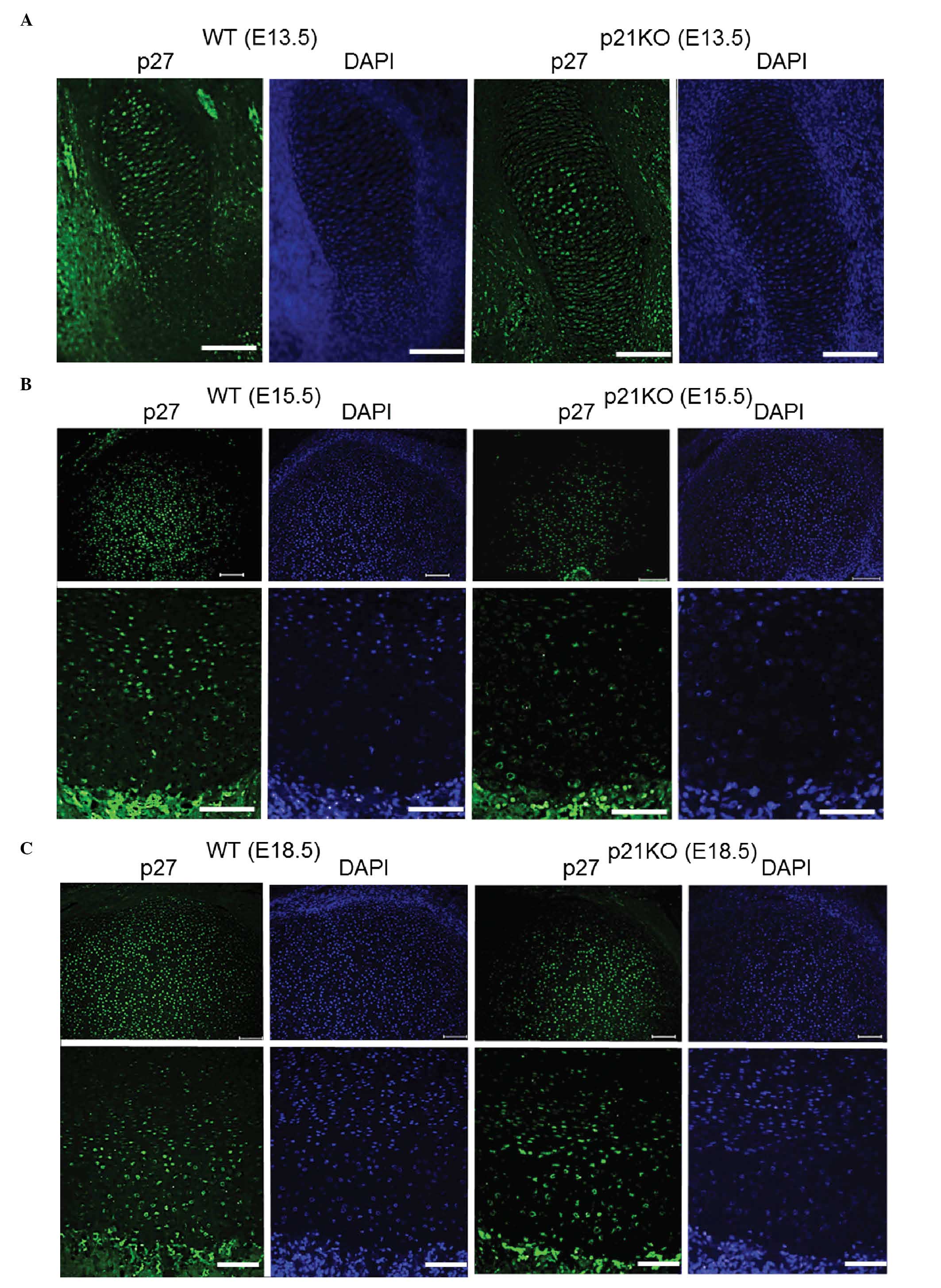Cyclin‑dependent kinase inhibitor p21 does not impact embryonic endochondral ossification in mice
- Authors:
- Published online on: November 6, 2014 https://doi.org/10.3892/mmr.2014.2889
- Pages: 1601-1608
-
Copyright: © Chinzei et al. This is an open access article distributed under the terms of Creative Commons Attribution License [CC BY_NC 3.0].
Abstract
Introduction
The number of patients with cartilage disorders has been increasing globally (1). This is a complex issue compounded by the lack of a consensus on treatment; hence, the development of a conclusive therapy for cartilage disorders is necessary.
The process of cartilage tissue growth or longitudinal growth, also known as endochondral ossification, occurs within the long bones at the growth plate located between the epiphysis and the metaphysis (2,3). At the growth plate, chondrogenic differentiation occurs from the diaphyseal side toward the metaphyseal side and chondrocytes are arranged longitudinally in a columnar shape, forming a layered structure. These organized chondrocytes are divided into three principal zones: The resting zone, the proliferative zone and the hypertrophic zone. The resting zone consists of small and immature chondrocytes, which differentiate into more mature chondrocytes in the proliferating zone. Large chondrocytes are found in the hypertrophic zone, where they exhibit a 5–10-fold increase in size (3). In the proliferative zone, chondrocytes produce numerous significant extracellular matrix proteins (ECM), including type II collagen and aggrican, which are structurally essential to the growth plate (4). In the hypertrophic zone, chondrocytes produce type X collagen as they cease to proliferate (5). In the adjacent metaphyseal zone, chondrocytes undergo apoptotic cell death, attract blood vessels and lay down a true bone matrix within the cartilage matrix (2). Thus, endochondral ossification is characterized by the continual proliferation, differentiation, and growth arrest of chondrocytes, and is regulated by a number of factors and hormones (2).
Cyclin-dependent kinases (CDKs) are widely recognized as regulators of cell cycle progression and CDK activation is regulated by CDK inhibitors (CKIs) (6,7). p21 is a CKI which has been identified as a cell cycle regulator; its induction by p53 during the DNA damage-induced G1-phase checkpoint response inhibits CDK4 and CDK2 (8–10). Asada et al (11) reported that cytoplasmic p21 also acts as an inhibitor of apoptosis and clinical research focusing on p21 has been conducted in the fields of angiology and oncology (12,13). Furthermore, the association between the p53/p21 pathway and induced pluripotent stem cell generation has been established (14,15). In the field of regenerative medicine, Bedelbaeva et al (16) reported that a p21-knockout mouse strain was able to close ear hole wounds and displayed increased morphological and histological regenerative responses when compared with the wild-type (WT) mouse strain, providing a firm link between cell cycle checkpoint control and tissue regeneration. Several studies have reported that the expression of p21 is essential for chondrogenesis in vitro (17,18). Negishi et al (4) reported that the progression of chondrogenic differentiation requires the downregulation of CDK2-associated kinase activity with an increase in the levels of p21 protein, and the subsequent degradation of this protein via a proteasomal pathway. Despite studies which indicate the importance of p21, the original study of p21-knockout mice in 1995 described that these mice may develop normally (19). However, these results were reported strictly in adult mice from histological findings in areas such as muscles and vertebrae. Additionally, this study did not contain any information regarding the roles of p21 in the development of articular cartilage of limbs. The aim of the present study was to clarify the function of p21 in the embryonic endochondral ossification of articular cartilage in mice.
Materials and methods
Mouse breeding
All procedures were approved by the Animal Studies Committee at Kobe University, Kobe, Japan. p21 knockout mice (B6.129S6 (Cg)-Cdkn1atm1Led/J) were obtained from The Jackson Laboratory (Bar Harbor, ME, USA). All mice were housed in cages under pathogen-free conditions and were allowed unlimited access to water and food.
The mice were bred in the animal facility at Kobe University Graduate School of Medicine (Kobe, Japan). To generate heterozygous mice, homozygous p21 knockout (KO) and WT mice (C57BL/6J; CLEA Japan, Inc., Tokyo, Japan) were mated. Next, heterozygous mice were mated to obtain embryos from the two groups of mice: p21 KO and WT. A total of ten mice were used for each experiment.
Tissue harvesting and decalcification
Pregnant heterozygous mice were anesthetized by an intraperitoneal injection of pentobarbital (50 mg/kg) and sacrificed by cervical disolcation at embryonic days E13.5, E15.5 and E18.5 (n=10 for each time point). Following collection of the embryos, the embryo forearms were dissected, fixed in 4% paraformaldehyde buffered with phosphate-buffered saline (PBS), decalcified with 10% formic acid and embedded in paraffin. Sagittal histological sections were cut at a thickness of 6 μm using a microtome and stained with Safranin O (Tokyo Chemical Industry Co., Ltd., Tokyo, Japan) and 5-bromo-2′-deoxyuridine (BrdU; BD Biosciences, San Jose, CA, USA). Tissue sections were also subjected to immunohistochemical and immunofluorescence analyses.
BrdU labeling and staining
To confirm the cell cycle progression at the G1/S phase, pregnant mice were injected intraperitoneally with 200 μl BrdU and sacrificed by cervical dislocation 2 h later to obtain embryonic tissues. Staining was performed using a BrdU In-Situ Detection kit (BD Biosciences, Franklin Lakes, NJ, USA) according to the manufacturer’s instructions and the sections were examined using a BZ-8100 confocal microscope (Keyence, Osaka, Japan).
Genotyping of mouse embryos
Genotypes were verified by polymerase chain reaction (PCR) analysis of tail-derived DNA. Genomic DNA was extracted using the DNeasy Blood & Tissue kit (Qiagen, Valencia, CA, USA). p21 deletion was confirmed by the presence of a 447-bp fragment unique to the mutant genotype, which was amplified with a p21-specific forward primer (5′-GTTGTCCTCGCCCTCATCTA-3′) and a mutant reverse primer (5′-CTGTCCATCTGCACGAGACTA-3′) (sequences provided by The Jackson Laboratory). WT alleles were confirmed by the presence of a 240 bp fragment amplified with the WT reverse primer (5′-GCCTATGTTGGGAAACCAGA-3′) and the p21-specific forward primer. DNA amplification was performed under the following PCR conditions: 94°C for 5 min, followed by 40 cycles of 94°C for 30 sec, 55°C for 30 sec and 72°C for 30 sec, and ending with 72°C for 2 min.
Immunohistochemistry
De-paraffinized sections were digested with proteinase (Dako Retrieval Solution Ready-to-Use; Dako, Glostrup, Denmark) for 20 min and treated with 3% hydrogen peroxide (Wako Pure Chemical Industries, Osaka, Japan) to block endogenous peroxidase activity. In addition to BrdU staining, the expression of cyclin D1 was examined to determine cell cycle progression at the G1/S phase, as cyclin D1 is a G1/S phase-specific protein (20). Furthermore, the expression levels of p16, type II collagen, type X collagen, and Sox9 were examined. INK4 is a tumor suppressor protein which causes G1 phase cell cycle arrest and p16 is a known representative of the INK4 family (21). Type II collagen is the foundation for articular cartilage and hyaline cartilage and it has been established that type X collagen is produced by hypertrophic chondrocytes (4). Sox9 is essential for chondrocyte differentiation and cartilage formation (22). Tissue sections were treated overnight at 4°C in Can Get Signal immunostain solution A (Toyobo, Tokyo, Japan) and the following antibodies: rabbit anti-mouse cyclin D1 polyclonal antibody (1:50 dilution; Cell Signaling Technology, Inc., Danvers, MA, USA), rabbit anti-mouse p16 polyclonal antibody (1:50 dilution; Abbiotec LLC, San Diego, CA, USA), rabbit anti-mouse type II collagen polyclonal antibody (1:100 dilution; Cosmo Bio Co., Ltd, Tokyo, Japan), rabbit anti-mouse type II collagen polyclonal antibody (1:50 dilution; Cosmo Bio Co., Ltd) and rabbit anti-mouse Sox9 polyclonal antibody (1:100 dilution; Abcam, Cambridge, UK). Subsequently, the sections were treated with horseradish peroxidase (HRP)-conjugated goat anti-rabbit immunoglobulin anitibody (N-Histofine® Simple Stain Mouse MAX PO (R); Nichirei Bioscience, Tokyo, Japan) at room temperature for 30 min. The signal was developed as a brown reaction product using the peroxidase substrate 3,3′-diaminobenzidine (Histofine Simple Stain DAB solution; Nichirei Bioscience), and the sections were examined using a BZ-8000 Confocal microscope (Keyence, Osaka, Japan).
Immunofluorescence
Deparaffinized sections were digested with proteinase (Dako Retrieval Solution Ready-to-Use) for 20 min and treated overnight at 4°C with the following antibodies in Can Get Signal immunostain solution A: Rabbit anti-mouse p27 polyclonal antibody (1:50 dilution; Santa Cruz Biotechnology, Inc.). The secondary antibodies used were goat anti-rabbit immunoglobulin Alexa Fluor 488 (1:200 dilution; Life Technologies, Carlsbad, CA, USA) for 30 min at room temperature. The nuclei were stained with DAPI and images were captured using a BZ-8000 confocal microscope (Keyence).
Statistical analysis
Statistical analysis was performed using the SPSS version 16.0 software package (SPSS, Inc., Chicago, IL, USA). The differences in the percentages of cyclin D1 or BrdU-positive cells between the groups at each time point were analyzed using the Mann Whitney U-test. P<0.05 was considered to indicate a statistically significant difference. All data are expressed as the mean ±standard deviation.
Results
Cartilage tissue morphology in embryonic mice is not altered by p21 deficiency
To investigate the in vivo function of p21 in chondrogenesis, a histological analysis of cartilage tissues was performed at E13.5, E15.5 and E18.5. Safranin O staining revealed no structural changes at any time point between the embryonic cartilage tissues of WT and p21KO mice (Fig. 1). These results indicate that p21 deficiency does not alter the morphology of embryonic cartilage tissue in mice.
Expression of ECM proteins and Sox9 is not altered by p21 deficiency
To investigate the in vivo function of p21 in ECM production, immunohistochemical analysis of cartilage tissue was performed at E13.5, E15.5, and E18.5. Type II collagen was expressed ubiquitously in the cartilage tissues. However, no differences were found between the embryonic cartilage tissues of WT and p21KO mice at any time point (Fig. 2A). Type X collagen was expressed in the hypertrophic zone. However, no differences were found between the embryonic cartilage tissues of WT and p21KO mice at each time point (Fig. 2B).
Immunohistochemical analysis revealed that the Sox9 expression levels of WT and p21KO mice did not differ at each time point (Fig. 2C). These results indicate that p21 deficiency does not affect ECM production in endochondral ossification.
Chondrocyte proliferation is not altered by p21 deficiency
The main function of p21 is as a negative regulator of the G1/S transition, inducing ‘G1 arrest’ (23). Cyclin D1 staining was performed to evaluate the cell cycle progression at the G1 phase. Cyclin D1 forms complexes with CDK4 or CDK6, whose activity is required for G1/S phase transition (7). Although the expression levels of cyclin D1 were higher in the E13.5 cartilage tissue compared with those at subsequent time points, no differences were found between the WT and p21KO mice (Fig. 3A). Enumeration of cyclin D1-positive chondrocytes showed significant decreases at E15.5 and E18.5 compared with that of E13.5 (P<0.05). However, no significant inter-group differences were identified at any time point (P>0.05) (Fig. 3B).
BrdU staining was performed as BrdU is incorporated into proliferating cells (S phase) allowing it to be used to evaluate DNA replication (24). The uptake of BrdU appeared to be much higher in the E13.5 cartilage tissue compared with that at subsequent time points. However, no differences in BrdU uptake were observed between the WT and p21KO mice (Fig. 3C). The number of BrdU-positive chondrocytes was significantly reduced at E15.5 and E18.5 compared with the number at E13.5 (P<0.05). However, no significant differences between the two groups were observed at each time point (P>0.05) (Fig. 3D). These results indicate that p21 deficiency does not affect chondrocyte proliferation and that chondrocyte proliferation is naturally more active during the early embryonic period.
Evaluation of the expression levels of p16
INK4 is a tumor suppressor and cell cycle regulatory protein that acts during the G1 phase. p16 is a known representative of the INK4 family which interacts with CDK4 and CDK6, inhibiting their ability to interact with cyclin D (25). While p16 was expressed ubiquitously throughout the tissue sections, no differences were observed between the expression levels in the WT and p21KO mice (Fig. 4).
Immunofluorescence evaluation of the expression of p27
The expression of p27, one of the Cip/Kip family components, was evaluated by immunofluorescence and DAPI staining (Fig. 5A–C). p27 was ubiquitously expressed throughout the tissue sections, however, no differences were observed between the expression levels in the WT and p21KO mice (Fig. 5).
Discussion
Accurate control of the cell cycle is essential for normal development, and CDKs are an integral part of cell cycle regulation (26). CDKs are specifically regulated by CKIs. Two distinct families of CKIs are known: Cip/Kip and INK4. The INK4 family consists of p15INK4b, p16INK4a, p18INK4c and p19INK4d, which specifically inhibit the activity of G1-phase cyclin D-CDK4 and CDK6 (7,25). The Cip/Kip family, including p21CIP1, p27KIP1 and p57KIP2, controls a broader spectrum of cyclin-CDK complexes, including CDK2, CDK3, CDK4 and CDK6 (7,27). Although members of the CIP/KIP family possess a few similar functions, they also possess different functions which are determined by the differences in expression pattern and protein structure.
Previous studies have reported that p27 has an important role in endochondral ossification. In p27KO mice, multiple organ overgrowth has been observed (28) and Emons et al (29) reported that p27KO mice demonstrated a modest increase in body length. Furthermore, the expression levels of p27 mRNA were similar throughout the hypertrophic and resting/proliferative zones in adult mice. In the present study, p27 was ubiquitously expressed in the tissue sections assessed.
Previous studies have reported that p21 is expressed in the majority of organs and tissues during murine embryonic and postnatal development (30,31). In myogenesis, the muscle-specific transcription factor MyoD induces p21 expression in association with the terminal differentiation of muscles (31), suggesting that p21 has a crucial role in muscle development (6). In the current study, it was demonstrated that p21 deficiency did not alter the morphology of embryonic cartilage tissue in mice, although p21 has been shown to be expressed in the proliferative and hypertrophic zones in adult WT mice (32). Furthermore, p21 deficiency did not affect ECM production or Sox9 expression.
Additionally, the expression of cyclin D1 and INK4 family members was evaluated. The expression levels of cyclin D1 and p16 did not differ between the WT and p21KO mice. The similarity of the expression levels of cyclin D1 and p16 indicates that there are no differences in the remaining activities of G1-phase that the Cip/Kip family are involved in. The uptake of BrdU was observed to be much higher at E13.5 compared with E15.5 and E18.5. However, no differences in BrdU uptake were found between WT and p21KO mice, revealing that the rate of development was equivalent. Taking these results into consideration, p21 deficiency did not affect chondrocyte proliferation.
Therefore, the primary finding of the current study is that p21 may not be essential for embryonic articular chondrogenesis in mice. Negishi et al (26) reported that the reduction of endogenous p21 caused inhibition of early chondrogenic differentiation in ATDC5 cells, indicating that the p21 gene has an important role in this cellular process in vitro (26). However, the current study did not observe any marked changes in vivo, revealing a discrepancy in these findings. While the impact of these results within the general scientific community may not be great, the results obtained from the KO mice provide important information for the researchers in relevant fields. These results revealed that p21 deficiency does not impact the morphology, ECM formation, chondrocytic marker protein production, chondrocyte proliferation or cell cycle regulatory proteins in the developing cartilage.
It has been hypothesized that various complicated mechanisms control the expression and timing of the Cip/Kip family, which appear to possess important roles in development and growth regulation (6). Therefore, p21 deletion may be compensated by a complicated mechanism involving other networks. Further studies are required to gain insight into these phenomena. A clear understanding of these mechanisms may lead to the development of novel therapeutic strategies for cartilage disorders.
In conclusion, the current study revealed that p21 does not impact embryonic endochondral ossification in articular cartilage of mice. Furthermore, compensation for the lack of p21 function does not appear to be mediated by components of the Cip/Kip family, p27.
Acknowledgements
This study was presented at the Orthopaedic Research Society Annual Meeting, 2014 (Poster no. 1322). The authors thank Ms. Kyoko Tanaka, Ms. Minako Nagata, Ms. Maya Yasuda, Mr. Takeshi Ueha for their technical assistance and Dr Mitsuru Morimoto for technical assistance and giving critical suggestions.
References
|
Cross M, Smith E, Hoy D, et al: The global burden of hip and knee osteoarthritis: estimates from the global burden of disease 2010 study. Ann Rheum Dis. 3:1323–1330. 2014. View Article : Google Scholar | |
|
Kronenberg HM: Developmental regulation of the growth plate. Nature. 423:332–336. 2003. View Article : Google Scholar : PubMed/NCBI | |
|
Emons J, Chagin AS, Sävendahl L, Karperien M and Wit JM: Mechanisms of growth plate maturation and epiphyseal fusion. Hormone Res Paediatr. 75:383–391. 2011. View Article : Google Scholar | |
|
Negishi Y, Ui N, Nakajima M, et al: p21Cip-1/SDI-1/WAF-1 gene is involved in chondrogenic differentiation of ATDC5 cells in vitro. J Biol Chem. 276:33249–33256. 2001. View Article : Google Scholar : PubMed/NCBI | |
|
Schmid TM and Linsenmayer TF: Immunohistochemical localization of short chain cartilage collagen (type X) in avian tissues. J Cell Biol. 100:598–605. 1985. View Article : Google Scholar : PubMed/NCBI | |
|
Nakayama K and Nakayama K: Cip/Kip cyclin-dependent kinase inhibitors: brakes of the cell cycle engine during development. BioEssays. 20:1020–1029. 1998. View Article : Google Scholar | |
|
Sherr CJ and Roberts JM: CDK inhibitors: positive and negative regulators of G1-phase progression. Genes Dev. 13:1501–1512. 1999. View Article : Google Scholar : PubMed/NCBI | |
|
He G, Siddik ZH, Huang Z, et al: Induction of p21 by p53 following DNA damage inhibits both Cdk4 and Cdk2 activities. Oncogene. 24:2929–2943. 2005. View Article : Google Scholar : PubMed/NCBI | |
|
Seoane J, Le HV and Massagué J: Myc suppression of the p21(Cip1) Cdk inhibitor influences the outcome of the p53 response to DNA damage. Nature. 419:729–734. 2002. View Article : Google Scholar : PubMed/NCBI | |
|
Harper JW, Adami GR, Wei N, Keyomarsi K and Elledge SJ: The p21 Cdk-interacting protein Cip1 is a potent inhibitor of G1 cyclin-dependent kinases. Cell. 75:805–816. 1993. View Article : Google Scholar : PubMed/NCBI | |
|
Asada M, Yamada T, Ichijo H, et al: Apoptosis inhibitory activity of cytoplasmic p21(Cip1/WAF1) in monocytic differentiation. EMBO J. 18:1223–1234. 1999. View Article : Google Scholar : PubMed/NCBI | |
|
Olive M, Mellad JA, Beltran LE, et al: p21Cip1 modulates arterial wound repair through the stromal cell-derived factor-1/CXCR4 axis in mice. J Clin Invest. 118:2050–2061. 2008.PubMed/NCBI | |
|
Gartel AL and Radhakrishnan SK: Lost in transcription: p21 repression, mechanisms, and consequences. Cancer Res. 65:3980–3985. 2005. View Article : Google Scholar : PubMed/NCBI | |
|
Hong H, Takahashi K, Ichisaka T, et al: Suppression of induced pluripotent stem cell generation by the p53-p21 pathway. Nature. 460:1132–1135. 2009. View Article : Google Scholar : PubMed/NCBI | |
|
Kawamura T, Suzuki J, Wang YV, et al: Linking the p53 tumour suppressor pathway to somatic cell reprogramming. Nature. 460:1140–1144. 2009. View Article : Google Scholar : PubMed/NCBI | |
|
Bedelbaeva K, Snyder A, Gourevitch D, et al: Lack of p21 expression links cell cycle control and appendage regeneration in mice. Proc Natl Acad Sci USA. 107:5845–5850. 2010. View Article : Google Scholar : PubMed/NCBI | |
|
Aikawa T, Segre GV and Lee K: Fibroblast growth factor inhibits chondrocytic growth through induction of p21 and subsequent inactivation of cyclin E-Cdk2. J Biol Chem. 276:29347–29352. 2001. View Article : Google Scholar : PubMed/NCBI | |
|
Nakajima M, Negishi Y, Tanaka H and Kawashima K: p21(Cip-1/SDI-1/WAF-1) expression via the mitogen-activated protein kinase signaling pathway in insulin-induced chondrogenic differentiation of ATDC5 cells. Biochem Biophys Res Commun. 320:1069–1075. 2004. View Article : Google Scholar : PubMed/NCBI | |
|
Deng C, Zhang P, Harper JW, Elledge SJ and Leder P: Mice lacking p21CIP1/WAF1 undergo normal development, but are defective in G1 checkpoint control. Cell. 82:675–684. 1995. View Article : Google Scholar : PubMed/NCBI | |
|
Baldin V, Lukas J, Marcote MJ, Pagano M and Draetta G: Cyclin D1 is a nuclear protein required for cell cycle progression in G1. Genes Dev. 7:812–821. 1993. View Article : Google Scholar : PubMed/NCBI | |
|
Byeon IJ, Li J, Ericson K, et al: Tumor suppressor p16INK4A: determination of solution structure and analyses of its interaction with cyclin-dependent kinase 4. Mol Cell. 1:421–431. 1998. View Article : Google Scholar : PubMed/NCBI | |
|
Bi W, Deng JM, Zhang Z, Behringer RR and de Crombrugghe B: Sox9 is required for cartilage formation. Nat Genet. 22:85–89. 1999. View Article : Google Scholar : PubMed/NCBI | |
|
Niculescu AB III, Chen X, Smeets M, Hengst L, Prives C and Reed SI: Effects of p21(Cip1/Waf1) at both the G1/S and the G2/M cell cycle transitions: pRb is a critical determinant in blocking DNA replication and in preventing endoreduplication. Mol Cell Biol. 18:629–643. 1998.PubMed/NCBI | |
|
Gratzner HG: Monoclonal antibody to 5-bromo- and 5-iododeoxyuridine: A new reagent for detection of DNA replication. Science. 218:474–475. 1982. View Article : Google Scholar : PubMed/NCBI | |
|
Cánepa ET, Scassa ME, Ceruti JM, et al: INK4 proteins, a family of mammalian CDK inhibitors with novel biological functions. IUBMB Life. 59:419–426. 2007. View Article : Google Scholar : PubMed/NCBI | |
|
Sherr CJ: G1 phase progression: cycling on cue. Cell. 79:551–555. 1994. View Article : Google Scholar : PubMed/NCBI | |
|
LaBaer J, Garrett MD, Stevenson LF, et al: New functional activities for the p21 family of CDK inhibitors. Genes Dev. 11:847–862. 1997. View Article : Google Scholar : PubMed/NCBI | |
|
Kiyokawa H, Kineman RD, Manova-Todorova KO, et al: Enhanced growth of mice lacking the cyclin-dependent kinase inhibitor function of p27(Kip1). Cell. 85:721–732. 1996. View Article : Google Scholar : PubMed/NCBI | |
|
Emons JA, Marino R, Nilsson O, et al: The role of p27Kip1 in the regulation of growth plate chondrocyte proliferation in mice. Pediatr Res. 60:288–293. 2006. View Article : Google Scholar : PubMed/NCBI | |
|
Macleod KF, Sherry N, Hannon G, et al: p53-dependent and independent expression of p21 during cell growth, differentiation, and DNA damage. Genes Dev. 9:935–944. 1995. View Article : Google Scholar : PubMed/NCBI | |
|
Parker SB, Eichele G, Zhang P, et al: p53-independent expression of p21Cip1 in muscle and other terminally differentiating cells. Science. 267:1024–1027. 1995. View Article : Google Scholar : PubMed/NCBI | |
|
Stewart MC, Farnum CE and MacLeod JN: Expression of p21CIP1/WAF1 in chondrocytes. Calcif Tissue Int. 61:199–204. 1997. View Article : Google Scholar : PubMed/NCBI |



